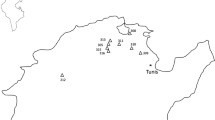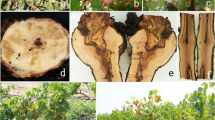Abstract
Powdery mildew (Golovinomyces ambrosiae) is one of the most significant leaf diseases in sunflower plants (Helianthus annuus). In the current study, the causative agent is identified morpho-anatomically as well as by molecular methods and is being reported here as a new record for Pakistan. The impact of the causative agent was observed regarding changes in plant metabolites and mycorrhizal establishment as well as by visual ratings of disease index. Results revealed that Golovinomyces ambrosiae is a new and significant leaf pathogen on Helianthus annuus in Pakistan. It can be cultured in vitro and in vivo conditions. For mass production of conidia of powdery mildews, greenhouse conditions are more appropriate than field conditions. It causes significant reduction of primary and secondary metabolites in sunflower. Regarding the influence of this disease on mycorrhizal root colonization, the current study revealed that mycorrhizal arbuscules increased significantly whereas there was no clear effect of disease severity on the number of vesicles observed. The correlation of mycorrhizal association with fungal pathogen infestation is important as arbuscular mycorrhizal fungi enhance plants resistance against biotrophic fungal pathogens such as powdery mildews.







Similar content being viewed by others
References
Avtar R, Rathi AS, Jatasra DS, Joshi UN (2003) Changes in phenolics and some oxidative enzymes in fenugreek leaves due to powdery mildew infection. Acta Phytopathol Entomol Hung. 38(4):237–244. https://doi.org/10.1556/APhyt.38.2003.3-4.3
Braun U, Cook RTA (2012) Taxonomic manual of Erysiphales (powdery mildews). CBS Biodiv Ser 11:1–707
Brundrett M, Bougher N, Dell B, Grove T, Malajczuk N (1996) Working with mycorrhizas in forestry and agriculture. ACIAR Monograph 32. Australian Centre for International Agricultural Research, Canberra, Australia
Chandra S, Khan S, Avula B, Lata H, Yang MH, ElSohly MA, Khan IA (2014) Assessment of total phenolic and flavonoid content, antioxidant properties, and yield of aeroponically and conventionally grown leafy vegetables and fruit crops: a comparative study. Evidence-Based Complem Alternat Med 2014:6. https://doi.org/10.1155/2014/253875
Chitarrini G, Zulini L, Masuero D, Vrhovsek U (2017) Lipid, phenol and carotenoid changes in ‘Bianca’ grapevine leaves after mechanical wounding: a case study. Protoplasma 254(6):2095–2106. https://doi.org/10.1007/s00709-017-1100-5
Farr DF, Rossman AY (2019) Fungal Databases, U.S. National Fungus Collections, ARS, USDA. Retrieved December, 2019, from https://nt.ars-grin.gov/fungaldatabases.
Feldmann F, Boyle C (1998) Concurrent development of arbuscular mycorrhizal colonization and powdery mildew infection on three Begonia hiemalis Cultivars. J Plant Dis Prot 2:121–129
Gao Y, Men XY, Yu Y, Zhou HX (2012) Changes of physiological indexes of jujube, peach, cherry, and grape leaves damaged by Apolygus lucorum in Northern China. Sci Agricola Sci 45(22):4627–4634
Gerdemann JW, Nicolson TH (1963) Spores of mycorrhizal Endogone species extracted from soil by wet sieving and decanting. Trans Brit Mycol Soc 46:235–244. https://doi.org/10.1016/S0007-1536(63)80079-0
Hall TA (1999) BioEdit: a user-friendly biological sequence alignment editor and analysis program for windows 95/98/NT. Nucleic Acids Symposium Series 41: 95–98
Hamza AM, Essa TA, Derbalah AS, Mohamed AA (2015) Performance of some fungicide alternatives for controlling powdery mildew on cucumber under greenhouse conditions. Egypt J Biol Pest Co 25(3):647–654. https://doi.org/10.1515/tjb-2016-0304
Huang JH, Zeng RS, Luo SM (2006) Studies on disease resistance of maize toward sheath blight induced by arbuscular mycorrhizal fungi. Chin J Eco-Agri 14:167–169
Karuna K (2012) Studies on the Etiology, Yield Loss Assessment, and Management of Powdery Mildew of Sunflower Helianthus annuus L. caused by Erysiphe cichoracearum DC (Doctoral dissertation, University of Agricultural Sciences, GKVK.
Kehri HK, Akhtar O, Zoomi I, Pandey D (2018) Arbuscular Mycorrhizal fungi: taxonomy and its systematics. Int J Life Sci Res 6(4):58–71
Kiss L (2003) A review of fungal antagonists of powdery mildews and their potential as biocontrol agents. Pest Manag Sci 59(4):475–483
Kumar S, Stecher G, Tamura K (2016) MEGA7: molecular evolutionary genetics analysis version 7.0 for bigger datasets. Mol Bio Evo 33(7):1870–1874. https://doi.org/10.1093/molbev/msw054
Liu Y, Feng X, Gao P, Li Y, Christensen MJ, Duan T (2018) Arbuscular mycorrhiza fungi increased the susceptibility of Astragalus adsurgens to powdery mildew caused by Erysiphe pisi. Mycology 9(3):223–232. https://doi.org/10.1080/21501203.2018.1477849
Morton JB, Benny GL (1990) Revised classification of arbuscular mycorrhizal fungi (Zygomycetes): a new order, Glomales, two new suborders, Glomineae and Gigasporineae, and two new families, Acaulosporaceae and Gigasporaceae, with an emendation of Glomaceae. Mycotaxon 37:471–491
Mukhtar I (2009) Sunflower disease and insect pests in Pakistan: a review. Afr Crop Sci J 17(2):109–118
Mulpuri S, Soni PK, Gonela SK (2016) Morphological and molecular characterization of powdery mildew on sunflower (Helianthus annuus L.), alternate hosts and weeds commonly found in and around sunflower fields in India. Phytoparasitica 44(3):353–367. https://doi.org/10.1007/s12600-016-0531-4
Nasim W, Ahmad A, Bano A, Olatinwo R, Usman M, Khaliq T, Hussain M (2012) Effect of nitrogen on yield and oil quality of sunflower (Helianthus annuus L.) hybrids under sub-humid conditions of Pakistan. Am J Plant Sci 3(2):243. https://doi.org/10.4236/ajps.2012.32029
NewshamFitter KKAH, Watkinson AR (1995) Multi-functionality and biodiversity in arbuscular mycorrhizas. Trends Ecol Evol 10:407–411. https://doi.org/10.1016/S0169-5347(00)89157-0
Phillips JM, Hayman DS (1970) Improved procedures for clearing roots and staining parasitic and vesicular-arbuscular mycorrhizal fungi for rapid assessment of infection. J Trans Br Mycological Soc 55:158–163. https://doi.org/10.1016/S0007-1536(70)80110-3
Pozo MJ, Cordier C, Dumas-Gaudot E, Gianinazzi S, Barea JM (2002) Localized versus systemic effect of arbuscular mycorrhizal fungi on defence responses to Phytophthora infection in tomato plants. J Exp Bot 53:525–534. https://doi.org/10.1093/jexbot/53.368.525
Rana A, Malannavar AB, Banyal DK (2018) Studies on biology and environmental factors affecting the development of tomato powdery mildew under protected cultivation. Indian Phytopathol 71(3):385–391
Ruiz-Lozano JM, Gianinazzi S, Gianinazzi-Pearson V (1999) Genes involved in resistance to powdery mildew in barley differentially modulate root colonization by the mycorrhizal fungus Glomus mossea. Mycorrhiza 4:237–240. https://doi.org/10.1007/s005720050273
Schenck NC, Perez Y (1990) Manual for the identification of VA mycorrhizal fungi Gainesville. Synergistic Publications, FL
Schovankova J, Opatova H (2011) Changes in phenols composition and activity of phenylalanine-ammonia lyase in apples after fungal infections. Hort Sci 38(1):1–10
Singh DP, Srivastava JS, Bahadur A (2004) Arbuscular mycorrhizal fungi induced biochemical changes in pea (Pisum sativum) and their effect on powdery mildew (Erysiphe pisi). J Plant Dis Prot 111:266–272
Smith SE, Read DJ (2008) Mycorrhizal symbiosis, vol 3. Academic, London
Sørensen CK, Thach T, Hovmøller MS (2016) Evaluation of Spray and Point Inoculation Methods for the Phenotyping of Puccinia striiformis on Wheat. Plant Dis. 100(6):1064–1070
Stöger A, Schaffer J, Ruppitsch W (2006) A rapid and sensitive method for direct detection of Erwinia amylovora in symptomatic and asymptomatic plant tissues by polymerase chain reaction. J Phytopathol 154(7–8):469–473. https://doi.org/10.1111/j.1439-0434.2006.01130.x
Talaat NB, Shawky BT (2014) Protective effects of Arbuscular mycorrhizal fungi on wheat (Triticum aestivum L.) plants exposed to salinity. Enviro Exp Bot 98:20–31. https://doi.org/10.1016/j.envexpbot.2013.10.005
Tamuli P, Saikia M, Boruah P (2013) Post-infectional biochemical changes in Cymbopogon martinii (Roxb.) Wats and Cymbopogon citratus (DC) Stapf. due to leaf rust disease. Am J Plant Sci 4(08):1666–1678. https://doi.org/10.4236/ajps.2013.48201
Thompson JD, Gibson TJ, Higgins DG (2003) Multiple sequence alignment using ClustalW and ClustalX. Curr Protoc Bioinform 1:2–3. https://doi.org/10.1002/0471250953.bi0203s00
Varma A, Choudhary DK (2019) Mycorrhizosphere and Pedogenesis. Springer, NY, p 420
Vigo C, Norman JR, Hooker JE (2000) Biocontrol of the pathogen Phytophthora parasitica by arbuscular mycorrhizal fungi is a consequence of effects on infection loci. Plant Pathol 49(4):509–514. https://doi.org/10.1046/j.1365-3059.2000.00473.x
Walker C (1983) Taxonomic concepts in the Endogonaceae: spore wall characteristics in species descriptions. Mycotaxon 18:443–455
Wang CX, Li XL, Song FQ, Wang GQ (2012) Effects of arbuscular mycorrhizal fungi on Fusarium wilt and disease resistance-related enzyme activity in cucumber seedling root. Chin J Eco-Agr 20:53–57
Waychal GU, Game BC, Jagtap SD (2018) Evaluation of fungicides for management of powdery mildew disease of okra (Abelmoschus esculentus Moench). Int J Commun Syst 6(2):325–327
Zimmer DE, Hoes JA (1978) Diseases in sunflower. science and technology, agronomy. In: Carter JF (ed) The American society of agronomy crop science society of america and soil science society of America. Publishers Madison, Wisconsin, NN
Acknowledgements
We are thankful to staff of the Botanical Garden, Institute of Botany, University of the Punjab, Lahore, for providing facilities to perform these experiments. We are also thankful to Dr. Muhammad Imran, Associate Professor, Institute of Chemistry, University of the Punjab, Lahore, Pakistan for his help in biochemical analysis. This work was financially supported by University of the Punjab, Lahore, Pakistan under a research project # D/6470/Est-1, entitled ‘SYSTEMATIC STUDY OF SOME FUNGAL PATHOGENS ON WILD PLANTS OF KHYBER PAKHTUNKHWA, PAKISTAN’ for the fiscal year 2019–2020.
Funding
University of the Punjab, Lahore, Pakistan, research project # D/6470/Est-1, Najam-ul-Sehar Sehar Afshan
Author information
Authors and Affiliations
Corresponding author
Ethics declarations
Conflicts of interests
All authors contributed equally to this study.
Additional information
Publisher's Note
Springer Nature remains neutral with regard to jurisdictional claims in published maps and institutional affiliations.
Rights and permissions
About this article
Cite this article
Afshan, N.u.S., Yaseen, A., Niazi, A.R. et al. Morphological and molecular characterization of Golovinomyces ambrosiae on sunflower (Helianthus annuus) in Pakistan, with its impact on plant metabolites and relative Mycorrhizal status. J Plant Dis Prot 129, 253–260 (2022). https://doi.org/10.1007/s41348-022-00564-0
Received:
Accepted:
Published:
Issue Date:
DOI: https://doi.org/10.1007/s41348-022-00564-0




